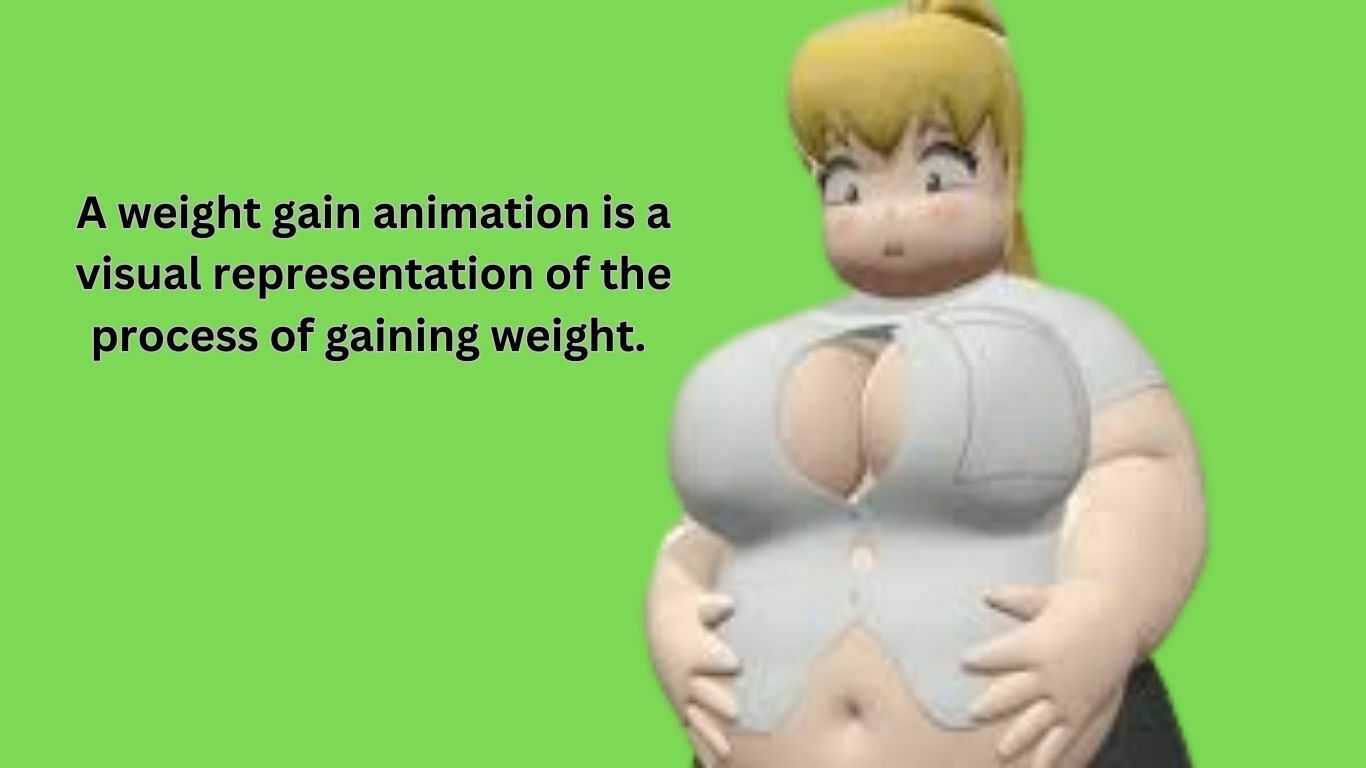A weight gain animation is a visual representation of the process of gaining weight. This type of animation is used for educational purposes, as it can help people understand the factors that contribute to weight gain and how to make healthy choices.
Gaining weight can be a complicated process, influenced by factors such as genetics, lifestyle, and diet. Weight gain animations can help people understand these factors and the impact they have on their bodies. They can also provide insight into healthy habits to adopt in order to achieve a healthy weight.
These animations can be found online or used by healthcare professionals to help patients better understand their health. Overall, weight gain animations are an effective tool for promoting healthy habits and preventing obesity.

Credit: www.deviantart.com
Understanding The Shocking Weight Gain Animation
The shocking weight gain animation is an eye-opening depiction of how our bodies change over time as a result of obesity. The video uses computer graphics to show viewers how our physical appearance and health can be drastically altered by excessive weight gain.
In this section, we will explore the key points of the weight gain animation and its implications for our health.
Explanation Of The Animation:
- The animation begins by showing a healthy individual with a normal body mass index (bmi) of 25.
- It then shows the same individual gradually gaining weight over time, with their bmi increasing to 30, 35, and beyond.
- The animation displays the effects of obesity on the body, including physical changes such as a larger waist circumference, increased body fat percentage, and the accumulation of visceral fat around organs.
- The video also shows how obesity can lead to serious health complications such as heart disease, diabetes, and certain types of cancer.
How It Depicts Weight Gain And Obesity:
- The weight gain animation illustrates how even a small increase in body weight can lead to significant changes in appearance and health.
- It emphasizes the accumulation of fat in the abdominal area, which can be both unsightly and a sign of more serious health issues.
- The animation also shows how obesity affects not just physical appearance but also internal organs, highlighting the importance of maintaining a healthy weight for overall health.
Implications Of Obesity:
- Obesity is a leading cause of preventable disease and death, and the weight gain animation drives home the seriousness of the issue.
- It reinforces the importance of maintaining a healthy weight through diet and exercise, and highlights the negative impact of excessive weight gain on physical appearance, self-esteem, and overall well-being.
- The animation also underscores the link between obesity and chronic conditions such as heart disease, diabetes, and cancer, emphasizing the importance of taking action to prevent and manage these conditions.
The weight gain animation is a powerful tool for educating people about the dangers of obesity. By highlighting the physical and health implications of excessive weight gain, the video drives home the importance of maintaining a healthy weight and avoiding the serious health complications associated with obesity.
The Negative Effects Of Obesity
Weight Gain Animation
Obesity is a condition that affects millions of people worldwide. The condition is characterized by the accumulation of excess body fat leading to a significant increase in weight. Although it may seem like a minor issue, the negative effects of obesity cannot be overlooked.
Health Problems Associated With Obesity
Obesity is a major risk factor for various health problems. Here are some of the health problems associated with obesity:
- Cardiovascular disease: Obesity increases the risk of high blood pressure, heart disease, and stroke.
- Type 2 diabetes: Obesity is the leading cause of type 2 diabetes.
- Respiratory problems: Obesity can cause respiratory problems such as sleep apnea and asthma.
- Joint problems: The accumulation of excess body fat adds pressure to the joints, leading to joint problems such as arthritis.
Mental Effects Of Obesity
Obesity can cause mental health problems, affecting an individual’s mental well-being. Here are some of the mental effects of obesity:
- Depression: Obesity can cause depression in individuals.
- Low self-esteem: The stigma surrounding obesity can cause low self-esteem in individuals.
- Anxiety: Being obese can cause anxiety in individuals, leading to social isolation and avoidance.
Impact Of Obesity On Daily Life
Obesity can have a significant impact on an individual’s daily life. Here are some of the impacts of obesity:
- Mobility: Being obese makes it hard for individuals to move around and perform basic activities such as walking and climbing stairs.
- Fatigue: Excess body fat can cause fatigue in individuals, leading to a decreased desire to partake in physical activity.
- Decreased lifespan: Obesity is linked to a decrease in lifespan, with the condition increasing the risk of premature death.
Psychological Effects Of Obesity
Obesity can lead to psychological problems, affecting one’s mental health. Here are some of the psychological effects of obesity:
- Addiction: Obesity can lead to addiction in individuals, with individuals turning to food as a coping mechanism.
- Eating disorders: Obesity can cause individuals to develop eating disorders such as binge eating disorder.
- Impaired cognitive functioning: Obesity can impair cognitive functioning, affecting an individual’s ability to perform everyday tasks.
The negative effects of obesity can range from physical health problems to psychological impacts. Obesity is a significant health problem and should be addressed to improve an individual’s overall health and well-being.
Causes Of Obesity
Obesity is a common health condition facing many individuals in our society today. Obesity is a medical condition where excess body fat has accumulated to an extent that it may have a negative impact on one’s health. Various factors contribute to obesity.
Let’s explore some of these factors under the following headings.
Genetics
Genetic factors play a vital role in the development of obesity. A family history of obesity is one of the primary indicators that genetics may be at play. Studies indicate that if one parent is obese, their child has a 50% risk of becoming obese as well.
If both parents are obese, the child’s risk of obesity may increase to 80%.
Lifestyle Choices
Lifestyle choices are another significant contributor to obesity. The following lifestyle choices may increase an individual’s risk of obesity:
- Lack of sleep
- Smoking
- Consuming alcohol regularly
- Living a sedentary lifestyle
- Lack of social support
Poor Nutrition
Poor nutrition is a well-known risk factor for obesity. The following nutrition habits may increase an individual’s risk of obesity:
- Overconsumption of processed foods high in fat, sugar, and salt
- Eating large portions of food
- Skipping meals regularly
- Consuming fast food frequently
Lack Of Physical Activity
A sedentary lifestyle is a major contributor to increasing rates of obesity. Lack of physical activity leads to burning fewer calories, which results in excess calories being stored as fat in the body. The following factors may contribute to a sedentary lifestyle:
- Desk jobs that require sitting for long hours
- Spending leisure time watching television or playing video games
- Relying heavily on vehicles to move around
Psychological Factors
Psychological factors can also contribute to the development of obesity. Mental conditions, such as depression and anxiety, may lead to unhealthy eating habits, which can result in weight gain. Emotional factors, such as stress and trauma, may also contribute to obesity.
As we have learned, various factors can contribute to the development of obesity. It is essential to understand these factors and take preventative measures to maintain a healthy lifestyle.
Prevention And Treatment Of Obesity
Weight Gain Animation: Prevention And Treatment Of Obesity
Obesity is a health condition characterized by excess body fat that increases the risk of chronic diseases such as diabetes, heart disease, and cancer. According to the world health organization (who), more than 1. 9 billion adults aged 18 years and above are overweight, and of these, over 650 million are obese.
Fortunately, you can prevent and treat obesity through specific lifestyle changes.
Strategies For Preventing Obesity
Obesity prevention requires taking steps towards a healthy lifestyle. Here are some strategies to help you prevent obesity:
- Make small, gradual changes to your eating habits and physical activity levels. This approach is more sustainable than drastic changes that are difficult to maintain.
- Monitor your food intake to ensure you eat a balanced diet that is low in calories, sugar, and fats. Include fresh fruits, vegetables, whole grains, and lean proteins in your meals.
- Keep yourself hydrated by drinking plenty of water. Avoid sugary drinks such as soda and energy drinks.
- Avoid taking food when you are not hungry or when you are bored or emotional.
- Get enough sleep, aim for at least 7-8 hours of quality sleep each night.
- Address emotional stress and tension by engaging in activities that help you relax such as meditation, yoga, or a hobby.
Healthy Eating Habits
Healthy eating is an integral part of preventing and treating obesity. Here are some healthy eating habits to consider:
- Eat a balanced and varied diet that focuses on whole foods.
- Control portion sizes to avoid eating too much food.
- Avoid eating out too often and opt for home-cooked meals instead.
- Chew your food slowly to aid digestion and give your brain enough time to register that you are full.
- Avoid unhealthy snacks and desserts, opt for nutritious alternatives such as fresh fruit or low-fat yogurt.
Regular Exercise
Regular physical activity is an effective way to prevent and manage obesity. Here are some tips on how to incorporate physical activity into your daily routine:
- Engage in regular aerobic activities such as brisk walking, jogging, cycling, or swimming for at least 150 minutes each week.
- Incorporate strength training exercises such as weight lifting, push-ups, and squats to build muscle mass and burn fat.
- Incorporate physical activity into your daily routine by taking the stairs instead of the elevator or walking instead of driving for short trips.
Medical Interventions
In some cases, lifestyle changes may not be enough to prevent or treat obesity. Medical interventions may be necessary. Here are some medical interventions for obesity:
- Prescription weight-loss medications can help with weight loss by suppressing appetite or reducing the absorption of fat.
- Bariatric surgery may be necessary for people with severe obesity. This procedure reduces the size of the stomach and alters the digestive system to limit food intake and promote weight loss.
Preventing and treating obesity requires adopting healthy lifestyle habits such as healthy eating, regular exercise, and stress management. By making gradual changes, you can achieve a healthy weight and improve your overall health and well-being.
How To Use Watch The Shocking Weight Gain Animation
Watching your weight gain can be a shocking experience, but it can also be essential for weight loss motivation. Luckily, an animation that shows weight gain can help you visualize the effects of unhealthy eating habits, encouraging you to make positive changes.
Here’s what you need to know about using the weight gain animation:
Steps To Access And Use The Animation
- Visit a weight loss website that offers a weight gain animation tool.
- Enter your starting weight and select how long you would like to animate (usually a week, month, or year).
- Press ‘play’ to watch the weight gain animation and see how your body changes over time.
Benefits Of Using The Animation For Weight Loss Motivation
- Seeing the physical impact of unhealthy eating habits can encourage you to make healthier choices and stick to your weight loss goals.
- The animation can help you identify patterns in your eating habits that are contributing to weight gain.
- It can be a powerful tool for motivation, keeping you focused on your weight loss journey.
Additional Resources For Weight Loss Support
- Many weight loss websites offer additional support, such as personalized meal plans, exercise routines, and community forums where you can connect with others on their own weight loss journeys.
- Consider working with a registered dietitian or personal trainer to personalize your weight loss plan and ensure you are on the right track.
- Keep in mind that weight loss is a process and can take time. Be patient with yourself and celebrate small victories along the way.
Incorporating a weight gain animation into your weight loss journey can be a helpful tool for visualization and motivation. As you work towards your goals, remember to be kind to yourself and seek support when needed. You got this!
Frequently Asked Questions Of Weight Gain Animation
What Is Weight Gain Animation?
Weight gain animation is a visual representation of how a person’s body changes with weight gain. It shows the gradual increase in fat distribution in different areas of the body over time.
How Does Weight Gain Animation Work?
Weight gain animation uses computer graphics and algorithms to create realistic visual representations of how a person’s body changes with weight gain. It draws from research on fat distribution patterns and applies it to individual cases.
What Are The Benefits Of Weight Gain Animation?
Weight gain animation provides a visual understanding of how a person’s body would change with weight gain. This can help individuals make informed decisions when it comes to weight management, and assist clinicians in educating patients on the potential implications of their lifestyle choices.
Is Weight Gain Animation Suitable For All Ages?
Weight gain animation may not be suitable for children and teenagers, as it can be a sensitive topic and may contribute to negative body image. It is best used in adults who have a developed sense of self-awareness and body confidence, and are looking for ways to manage their weight and improve their overall health.
Can Weight Gain Animation Be Used For Weight Loss Too?
While weight gain animation is primarily designed to show the effects of weight gain, it can also be used to show potential weight loss outcomes. This can serve as a motivating factor for individuals who are struggling with weight management and looking for ways to make meaningful changes to their lifestyle.
Conclusion
Weight gain animation can be a source of information and inspiration for those who aim to gain weight. It is an effective tool that enables individuals to visualize their progress and stay motivated. By creating a weight gain animation, you can track your progress and set achievable goals.
Remember that gaining weight takes time and patience, and the key to success is consistency. Along with implementing a healthy lifestyle and nutrition plan, incorporating exercise into your routine is crucial. By engaging in strength training exercises, you can build muscle mass, which in turn increases your overall weight.
If you are looking to gain weight, make use of weight gain animation to track your progress, set achievable goals, and stay motivated throughout the journey to meet your desired weight.




